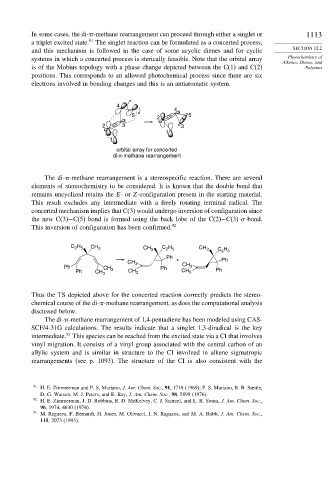Page 1128 - Advanced Organic Chemistry Part A - Structure and Mechanisms, 5th ed (2007) - Carey _ Sundberg
P. 1128
In some cases, the di- -methane rearrangement can proceed through either a singlet or 1113
91
a triplet excited state. The singlet reaction can be formulated as a concerted process,
and this mechanism is followed in the case of some acyclic dienes and for cyclic SECTION 12.2
systems in which a concerted process is sterically feasible. Note that the orbital array Photochemistry of
Alkenes, Dienes, and
is of the Mobius topology with a phase change depicted between the C(1) and C(2) Polyenes
positions. This corresponds to an allowed photochemical process since there are six
electrons involved in bonding changes and this is an antiaromatic system.
4
4
5 5
2
2 3 3
1
1
orbital array for concerted
di-π-methane rearrangement
The di- -methane rearrangement is a stereospecific reaction. There are several
elements of stereochemistry to be considered. It is known that the double bond that
remains uncyclized retains the E-or Z-configuration present in the starting material.
This result excludes any intermediate with a freely rotating terminal radical. The
concerted mechanism implies that C(3) would undergo inversion of configuration since
the new C(3)−C(5) bond is formed using the back lobe of the C(2)−C(3) -bond.
This inversion of configuration has been confirmed. 92
C H CH 3 CH 3 C 2 H 5 CH 3 C H
2 5
2 5
Ph + Ph
CH 3 CH
Ph CH Ph 3
Ph CH 3 3 CH 3 CH 3 Ph
Thus the TS depicted above for the concerted reaction correctly predicts the stereo-
chemical course of the di- -methane rearrangement, as does the computational analysis
discussed below.
The di- -methane rearrangement of 1,4-pentadiene has been modeled using CAS-
SCF/4-31G calculations. The results indicate that a singlet 1,3-diradical is the key
93
intermediate. This species can be reached from the excited state via a CI that involves
vinyl migration. It consists of a vinyl group associated with the central carbon of an
allylic system and is similar in structure to the CI involved in alkene sigmatropic
rearrangements (see p. 1093). The structure of the CI is also consistent with the
91
H. E. Zimmerman and P. S. Mariano, J. Am. Chem. Soc., 91, 1718 (1969); P. S. Mariano, R. B. Steitle,
D. G. Watson, M. J. Peters, and E. Bay, J. Am. Chem. Soc., 98, 5899 (1976).
92 H. E. Zimmerman, J. D. Robbins, R. D. McKelvey, C. J. Samuel, and L. R. Sousa, J. Am. Chem. Soc.,
96, 1974, 4630 (1974).
93
M. Reguero, F. Bernardi, H. Jones, M. Olivucci, I. N. Ragazos, and M. A. Robb, J. Am. Chem. Soc.,
115, 2073 (1993).

